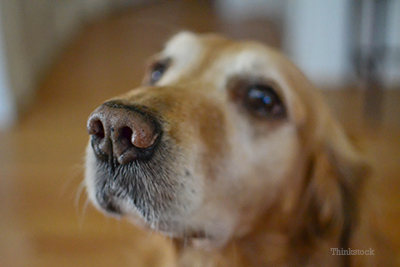
What is canine hyperkeratosis?
Normally, the specialized skin that makes up the surface of a dog’s nose (the planum nasale) and feet (the digital, carpal and tarsal pads) is quite smooth and soft. In some situations this skin can become thickened and cracked—a condition called hyperkeratosis. The thickening and cracking that occur in either area may be progressive and can become quite uncomfortable, even causing lameness1.
Why does hyperkeratosis occur?
In some dogs there may be a genetic predisposition to hyperkeratosis. It may occur hereditarily in certain breeds like Golden Retrievers, Labrador Retrievers, Irish Setters and Bedlington Terriers, among others1. In this familial form of the disease, symptoms are usually present by 6 months of age, which is fortunate since then the decision can be made not to breed the affected dog. In contrast, the idiopathic form (those cases where a specific cause cannot be determined) is most likely to develop in dogs over 10 years of age1.
Hyperkeratosis of foot pads and nasal surfaces can also be associated with other medical conditions. For instance:
- Certain nutritional imbalances such as zinc responsive dermatosis (according to DVM360)
- Some infectious diseases like Canine Distemper (sometimes refered to as “hardpad disease” because of this associated symptom)
- Leishmaniasis
- Immune mediated diseases like pemphigus foliecious (your dog produces antibodies against different components of the skin, resulting in separation of the cells and blistering of the skin)
Testing for hyperkeratosis
Typically dogs with underlying infectious and immune mediated diseases will have other lesions and/or illness that will lead your veterinarian to suspect these conditions as the cause of your dog’s hyperkeratosis. Those conditions will then require blood tests and further evaluation.
Without overt evidence of other illnesses, though, most cases of hyperkeratosis require skin biopsies that are then evaluated along with your dog’s breed information, history and physical findings.
Treatment and management of hyperkeratosis
As you might imagine, the management of your dog’s hyperkeratosis depends on the specific cause; so the diagnosis is an important step. Most cases will require treatment of the symptoms. A cure might not be possible; however, the condition is largely cosmetic and can usually be managed, according to Animal Dermatology Specialists of Vancouver.
When necessary, the treatment will be directed at any underlying disease:
- Immunosuppressive drugs for pemphigus
- Zinc supplementation for zinc responsive cases
In general, though, treatment consists of moisturizers and softening agents to keep the affected areas as supple as possible and avoid cracking fissures. In severe cases, especially those with excess hard skin, the tissue must routinely be trimmed.
Questions to ask your veterinarian:
- What causes the thickening and roughness of my dog’s nose?
- My dog’s footpads are extremely thick and hard, with featherlike edges. What can I do to help the condition?
If you have any questions or concerns, you should always visit or call your veterinarian -- they are your best resource to ensure the health and well-being of your pets.
Resources:
